Create a virtual hard drive, turn the real machine into a virtual machine with Disk2vhd
TipsMake.com - Have you ever dreamed of a way to turn your real machine into a virtual machine for testing? Today we will look at Disk2VHD as a simple solution to convert real Windows machines into virtual machines .
Disk2VHD is a tool for converting real machines to Microsoft virtual machines, one of Windows Sysinternals tools. It is very light, simple interface and easy to use.
Disk2VHD runs on Windows Vista, Windows Server 2008 or later, supporting both x64 versions.
Run Disk2VHD 
Disk2VHD allows you to create a Virtual Hard Drive (VHD) of the real machine while the real machine is running, using 'volume snapshot' technology . This utility does not require installation and you can run it from USB if you wish. Just open the Disk2vhd folder and run the executable file. 
Agree to the terms of registration .

Now select the real drive you want to switch to a VHD, give it a name and locate the path to create and store it. You need to select a path that is large enough to store the VHD you just created. In this example we create VHD from an IBM ThinkPad machine running Windows XP. Note the required capacity under the Volumes to include section specifying 6.48GB and drive E: left to 8GB. Also, if you create a VHD from Windows XP or Server 2003 and will run it on Virtual PC, check the box Fix up HAL for Virtual PC . After everything is done, click the Create button.

You will see the progress bar while the VHD is created. The XP virtual machine from an IBM Thinkpad G40 machine used for testing in this case will take about an hour to complete. The amount of time to create VHD will be different for each system.

Install on Windows Virtual PC
Here we look at how to run a new VHD created on Virtual PC in Windows 7. We need to create a new machine first, so we need to open Windows Virtual PC from the Start Menu.
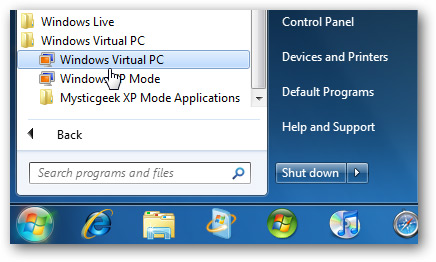
In the Virtual Machine folder, click Create Virtual Machine to start the process
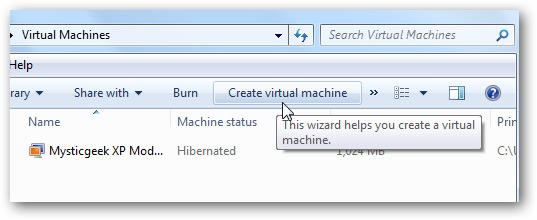
Then give it a name like the one below:
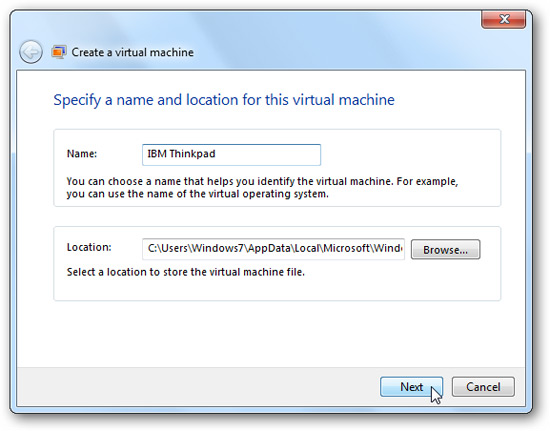
Select the amount of memory allocated to the virtual machine and select the network setting.
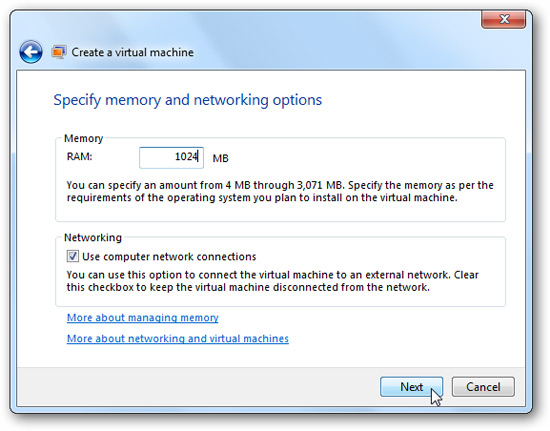
In the next step of the process, we need to point to the VHD path and click Create .
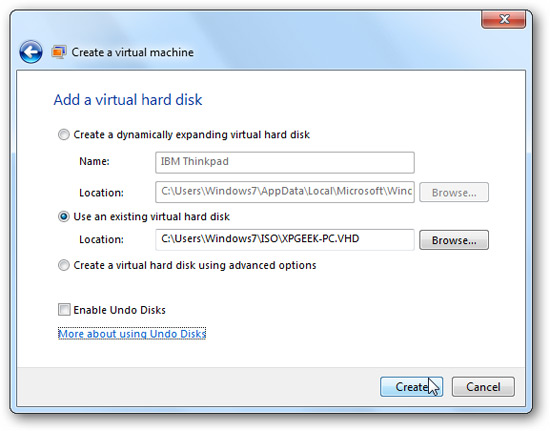
The newly created virtual machine will be replaced in the Virtual Machines folder
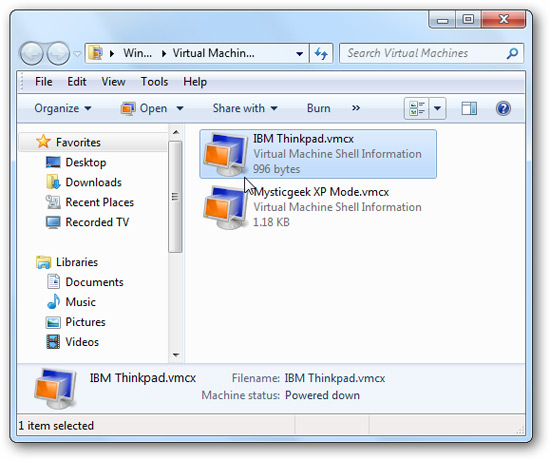
There are a few things to keep in mind in this XP virtual machine: because we transfer it from another computer, we need to re-enable the XP registration code.
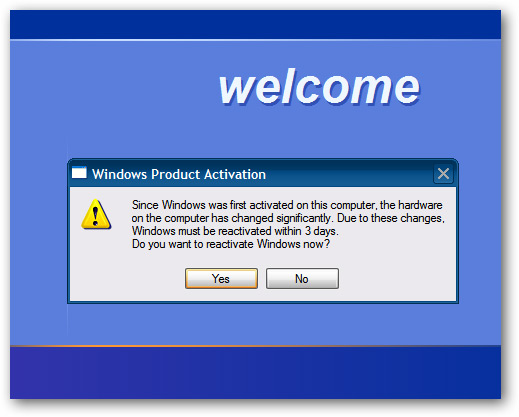
The "find new hardware" process will appear when XP starts to indicate that it detected other hardware on the virtual machine. We can skip these processes and the virtual machine still works fine.

Then run Enable integration Features from the Tools menu on Virtual PC
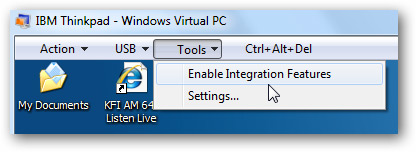
A process will appear in the virtual machine until it is completed, then restart the virtual machine.
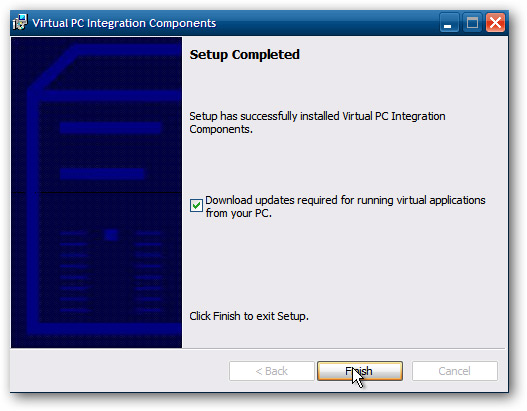
After the boot is complete, you can start using it.
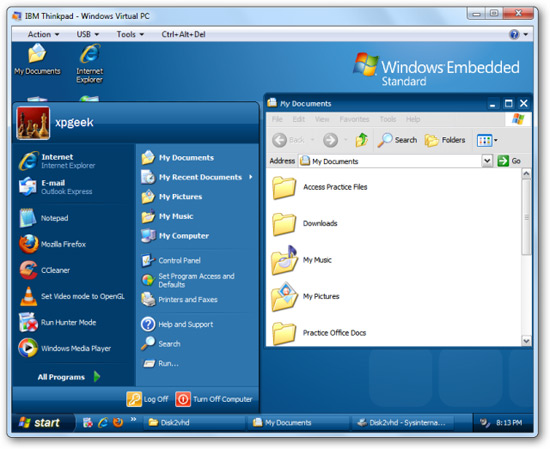
Note when using Disk2VHD
Some versions of Windows allow you to mount a virtual hard drive on your computer just by double-clicking on the virtual hard drive, from which you can access the contents of the virtual drive. So be careful with the virtual hard drive file you just created with Disk2VHD.
This sounds quite convenient, in theory, you can create a virtual hard drive, open it, add some drivers, and then remove the virtual drive, attach it to the virtual machine and use. However, you need to keep in mind that: When performing a real computer conversion to a virtual machine, Disk2VHD does not destroy the contents of the real machine, the server remains intact and works normally after conversion. This is the problem.
The Windows operating system creates a signature for each drive, which is used as a mechanism to help Windows identify the drive. Because the virtual drive correctly copies the physical drive, it also contains the same signature as the physical drive it copies. Therefore, if you attach the virtual drive to the real machine used to create the virtual disk, a signature conflict will occur. Windows will try to resolve this conflict by creating a new signature for the virtual drive. When you do, Windows will render to a virtual hard drive that cannot be booted. If you attach this virtual drive to the virtual machine, the virtual machine will not be able to boot because the Boot Configuration Database of the drive referring to a drive signature no longer exists.
Another important note is that you must be careful when using this tool on running systems. Disk2VHD works similar to how backup applications work. It uses Volume Shadow Copy Service (VSS) to create snapshots of the drive to be converted. As a result, do not change the contents of the drive during the conversion process, ensuring the integrity of the virtual hard drive, but the downside is that any data created or modified on the real drive takes place. During or after the conversion process will not be copied to the virtual drive. This can cause data loss, especially on systems running high transactional applications, such as Exchange Server. This server should use data replication to support virtualization, or manually deploy Exchange Server on a virtual machine rather than relying on Disk2VHD.
In addition, you may have to make some adjustments to the virtual machine before you can use it, such as installing Hyper-V integration services or changing the network configuration. This is because during the physical transformation the server will lose the IP address configuration, since the virtual NIC has a different name from the physical NIC. Therefore, you must record the server's IP address configuration before virtualization so that they can be assigned to the server's virtual NIC.
Conclude
You can also run the VHD on a Microsoft Hyper-V virtual machine on the 2008 server. In short, Disk2VHD can be used to create images of different machines for testing without worrying about damaging the real machine. . So it can be used in case of backing up your computer. It is completely free, requires no installation, and will create a VHD while the computer is running.
See more:
- Dual Boot Windows 7 with Virtual Hard Disk
- Here's how to create a Virtual Hard Disk on Windows 10
- Share files between 2 computers using Target Disk Mode
- Is it good to use USB as a virtual memory for the computer?
You should read it
- Create virtual machines with Hyper-V on Windows 8 and Windows 10
- Create virtual machines in Hyper-V on Windows Server 2008
- Create clone virtual machine for current Windows hard drive
- How to create a virtual drive on Windows with Simple VHD Manager
- Create dualboot system with Windows 7 and 8 using VHD
- What is virtual memory? How to set Virtual memory for Windows computers
- How to create a virtual machine in Windows Server 2012
- How to create a virtual phone number to receive messages
May be interested
- How to turn off the hard drive after not working in Windows 10
 installing turn off hard disk after in power options allows the user to set the power to the hard drive (hdd) to be turned off, after detecting it has been inactive for a period of time. this setting will not affect ssd or nvme drives.
installing turn off hard disk after in power options allows the user to set the power to the hard drive (hdd) to be turned off, after detecting it has been inactive for a period of time. this setting will not affect ssd or nvme drives. - Instructions on how to create a RAM drive on Windows
 if you've ever wanted to simulate the performance of a solid state drive (ssd) without having to add a new hardware, try creating a new virtual hard drive on your pc that runs entirely from ram, also called ram drive (of course if the system has enough ram). the article will show you how to configure the ram drive on your pc.
if you've ever wanted to simulate the performance of a solid state drive (ssd) without having to add a new hardware, try creating a new virtual hard drive on your pc that runs entirely from ram, also called ram drive (of course if the system has enough ram). the article will show you how to configure the ram drive on your pc. - How to Back Up a Mac Without Time Machine
 this wikihow teaches you how to create a backup of your mac's hard drive contents without using time machine. buy an external hard drive. since you'll be using the external hard drive to back up your entire mac hard drive, the drive should...
this wikihow teaches you how to create a backup of your mac's hard drive contents without using time machine. buy an external hard drive. since you'll be using the external hard drive to back up your entire mac hard drive, the drive should... - Create dualboot system with Windows 7 and 8 using VHD
 in the following article, we will show you how to create and use virtual hard drive (vhd) to install and start windows 8 on a working computer using windows 7. actually, in fact there are quite a few ways to do this, and the way presented below is simple and easy to implement
in the following article, we will show you how to create and use virtual hard drive (vhd) to install and start windows 8 on a working computer using windows 7. actually, in fact there are quite a few ways to do this, and the way presented below is simple and easy to implement - The simplest way to create a virtual drive using Virtual Drive
 virtual drive helps create virtual drives quickly, allowing you to run iso files without using a physical cd/dvd drive. this tool is good for installing software, games and working with data.
virtual drive helps create virtual drives quickly, allowing you to run iso files without using a physical cd/dvd drive. this tool is good for installing software, games and working with data. - How to identify SSD hard drive is real or fake
 currently, clone ssd drives are rampant with many sophisticated tricks so users are easily fooled. therefore, use the following tips to avoid buying poor quality ssds.
currently, clone ssd drives are rampant with many sophisticated tricks so users are easily fooled. therefore, use the following tips to avoid buying poor quality ssds. - Setting up Ubuntu virtual machine with Hyper-V Quick Create on Windows 10
 how to use hyper-v quick create and install ubuntu virtual hard disk to set up ubuntu linux virtual machine
how to use hyper-v quick create and install ubuntu virtual hard disk to set up ubuntu linux virtual machine - How to create a Windows 10 virtual machine with VMware Player and VirtualBox
 having a virtual machine at hand can be useful for a variety of purposes, such as testing software or edits in a sandbox environment separate from your main operating system.
having a virtual machine at hand can be useful for a variety of purposes, such as testing software or edits in a sandbox environment separate from your main operating system. - How to turn an old hard drive into an external drive?
 it's easy to turn an old (or new) hard drive into a perfect external drive to store your secondary files.
it's easy to turn an old (or new) hard drive into a perfect external drive to store your secondary files. - Partition to create the second hard drive on Windows
 if you want to split the hard drive into different parts, you can use partitions to do that. with disk management - a default windows tool, we will introduce you to all terms and instructions on how to resize, delete and create partitions. basically, this is a virtual process to add additional hard drives.
if you want to split the hard drive into different parts, you can use partitions to do that. with disk management - a default windows tool, we will introduce you to all terms and instructions on how to resize, delete and create partitions. basically, this is a virtual process to add additional hard drives.










 Learn about Microsoft Operations Studio from Microsoft
Learn about Microsoft Operations Studio from Microsoft Implement these tasks first when transferring data to Windows Server 2019
Implement these tasks first when transferring data to Windows Server 2019 Create private cloud with Hyper-V (Part 2)
Create private cloud with Hyper-V (Part 2) Create private cloud with Hyper-V (Part 3)
Create private cloud with Hyper-V (Part 3) Create private cloud with Hyper-V (Part 4)
Create private cloud with Hyper-V (Part 4) Create private cloud with Hyper-V (Part 5)
Create private cloud with Hyper-V (Part 5)